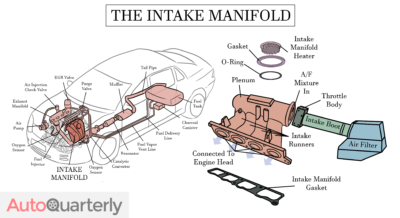The engine in your car has a lot of parts that are bolted together. Usually, these parts have a gasket between them. Those gaskets keep fluids and air inside the motor while the parts expand and contract due to heat and vibrations. When a gasket fails, it can cause your motor to run poorly.
This article will be looking at the problems caused when one particular gasket, the intake manifold gasket, fails. We’ll start by looking at the symptoms of a bad gasket. We’ll also talk about what an intake manifold is and how to diagnose a failed gasket. Finally, we’ll discuss the costs involved in replacing the gasket, either at a shop or doing it yourself.
Symptoms of a Bad Intake Manifold Gasket
The following signs are good indicators that you may have a bad intake gasket. Usually there will be more than one symptom since the intake manifold is an important part of engine performance.
Common Symptoms
These are some of the most common symptoms of a bad intake manifold gasket.
- Rough idle
- Reduced fuel efficiency
- Check engine light is on
- Unusual noises like whistling, sucking, or gurgling
Coolant Based Symptoms
Some cars use the intake manifold to route coolant. If your car uses this design, it may experience the following symptoms. Be aware that many of these symptoms are the same as a bad head gasket, and you should not drive the car if you are experiencing them.
- White smoke from the tailpipe
- Coolant leaking and pooling
- Overheating
- A sweet smell around the engine (Coolant has a very distinct odor when burned)
- Low coolant levels
How an Intake Manifold Works
Your motor needs three things to run: fuel, air, and a spark. Many YouTube videos explain the process better, such as these amusing animations if you would like to know more. In this article, we are concerned with the air part of the equation; intake manifold is actually a short way to say “air and fuel intake manifold.”
It is a series of pipes or chambers that allow air to be sucked in and distributed to the cylinders. Fuel is sprayed into the intake manifold on many cars, either from injectors or a carburetor, where it can mix with air. This air/fuel mixture is then directed into a cylinder.
You can find the intake manifold on your vehicle by first finding the air filter. The air filter will be connected by a length of tubing to the intake manifold on modern cars. The filter sits on top of the carburetor on older cars, which is bolted directly to the intake manifold.
Coolant
Besides distributing air or an air/fuel mixture to the cylinders, some intakes also have coolant flowing through them. You will mostly find this intake style on engines configured in the V shape since the intake manifold bridges the gap between the two cylinder banks.
The Intake Manifold Gasket
Since air and fuel need to flow through the intake manifold into the cylinders, there needs to be a gasket sealing the intake manifold to the cylinder head or heads. If that gasket fails, it can allow air to leak out. That will ruin the air-fuel ratio and cause a less precise burn, which will cause your car to run poorly.
On intakes that direct coolant, a broken gasket will also cause coolant to leak into the intake or out onto the motor. If you ever see coolant where it’s not supposed to be or see white smoke coming from your tailpipe, it’s important to stop the car. Those are symptoms of a bad intake gasket and a bad head gasket, and it can be difficult to tell which gasket has failed. Driving with a bad head gasket is dangerous and can harm the engine even further.
Sensors
Intake manifolds have a range of sensors installed on them. The Manifold Absolute Pressure sensor, or MAP, helps the computer calculate the air and fuel mixture to ensure you are getting the best efficiency possible. Other sensors measure things like temperature, vacuum, and more depending on the car.
If there is a leak, the sensors will not be getting an accurate reading. This will often cause a check engine light to come on since the intake sensors will begin to disagree with other engine sensors.
Diagnosing the Issue
Unfortunately, as we stated above, a bad intake gasket will cause many of the same symptoms as other problems. The following steps should be taken to ensure that the intake gasket is the cause of your issues.
- If you have a car equipped with an onboard diagnostic system, scan for error codes using a scanner. OBD scanners like these we recommend are inexpensive and easy to use. Error codes, including cylinder misfire, insufficient flow, and flow sensor errors, are common when an intake gasket is faulty.
- Pull out the spark plugs and inspect them. If the vehicle has a bad air/fuel ratio or a coolant leak, it will often foul the spark plug. You can use this chart to check.
- Test for an air leak using a smoke machine. You can watch the process here. Smoke leaking from between the manifold and the cylinder heads indicates a broken gasket.
- Test for coolant leaks using a pressure tester. You can watch the process here. You will hear gurgling and be able to see bubbles around the intake.
Home mechanics and people who don’t want to spend money on expensive machines to diagnose the issue may find that the best option is simply replacing the gasket. The gasket is inexpensive, and if the issue goes away, you are done. We will cover that process in the next section.
Replacing the Intake Manifold Gasket

On most vehicles, the intake gasket can be replaced with only simple hand tools. It is, however, fairly time-consuming. There are often many pieces attached to the intake that must be labeled and removed. The gaskets themselves are usually very inexpensive, so you can save a lot of money doing it yourself if you have the time.
Taking the Car to a Shop
The cost of taking your car to a mechanic to replace the intake gasket can vary quite a bit based on your engine’s complexity. Older, simpler cars require less work to expose the gasket than newer cars that often have tons of sensors everywhere. The size of your motor will also directly affect how long it takes to remove the intake.
You can expect to pay $200-300 for a small motor with a few layers that must be removed. An older Honda Civic or similar economy car will fit into this category.
You can expect to pay $300-500 for a large or complex motor. A new Honda Civic has many wires, sensors, and extra layers that must be removed before the gasket can be accessed. A large truck like a Ford F-250 can be difficult to work on because of its size.
Doing It Yourself
Gaskets, like this one for a 2005 Civic Si, tend to be very inexpensive. You can save hundreds of dollars by replacing it yourself. We have a handful of tips and tricks to make sure the process goes as smoothly as possible.
Label Everything
The intake manifold gasket is often the third or fourth layer as you work down from the top of the motor. That means there are a lot of small brackets, bolts, wires, and parts that have to be removed before you get to the gasket. Use plastic bags, containers, and paint pens to label everything so it can go back in the right spot.
Clean and Inspect as You Work
Since the intake manifold is rarely removed, you should take the opportunity to clean the inside of the intake with a good engine cleaner. You should also inspect parts as you take them off and replace corroded bolts, broken connectors, and other similar issues.
Consider replacing your mass airflow sensor if you haven’t already. MAFs are easily damaged and often cause the same engine performance problems that a leaking gasket will cause when they go bad. They are fairly inexpensive, and you will probably have to remove them anyway to get to the intake gasket.
Use a Torque Wrench
Many modern intake manifolds are aluminum or plastic, and they are very sensitive to over-torquing. Be sure to follow the instructions as laid out in a service manual. You will often find that an intake manifold will need to be tightened in stages and in a specific pattern. It’s very similar to replacing an engine head.
Install the Gasket Carefully
Some cars require gaskets that can be installed upside down or off-center. Be careful to install the gasket correctly and not pinch or roll an edge as you reinstall the intake manifold. It can be frustrating to accidentally destroy a gasket while putting a car back together; trust us, we know from experience.
Also, note that some gaskets require grease or specifically advise against using other compounds like RTV sealant. It’s very common to use a dab of gasket maker or sealant to hold a gasket in place while you work, but be sure to read the directions just in case the gasket is made of a material that can be damaged by those chemicals.
Wrapping Up
Nobody likes it when a motor is misbehaving. Fortunately, a broken intake manifold gasket is a fairly straightforward problem to fix. The parts are inexpensive, and chances are you can be up and running again worry-free in an afternoon.



